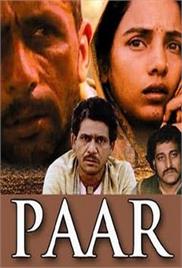Be Careful of Fake Websites. Always use HindiMovies.to domain & Join our Telegram Channel for Latest Updates.

Likes: 3
Views: 1.81K
This is Goutam Ghose’s speculative commentary on poverty and exploitation in rural Bihar, based on Bengali story Paathi.
Duration: 141 min
Released: 1984
IMDb Rating: 7.2/10 (158 Votes)
Genre: Drama, Hindi Movies
Stars: Anil Chatterjee, Naseeruddin Shah, Utpal Dutt, Shabana Azmi
Directors: Goutam Ghose
Writers: Partha Banerjee, Samaresh Basu, Goutam Ghose, Partho Mukerjee
Year: 1984
Server 1 – Dailymotion
Server 2 – Dailymotion
Server 3 – Youtube
Server 4 – Youtube
Server 5 – Youtube
Server 6 – Youtube
Server 7 – Youtube
Paar (1984): A Tale of Survival and Human Endurance
Introduction
Released in 1984, "Paar" is a poignant Hindi drama directed by the acclaimed filmmaker Goutam Ghose. Known for his insightful and realistic depiction of rural India, Ghose crafts a compelling narrative that delves deep into the struggles of common people against the harsh backdrop of socio-economic adversity. Starring powerhouse actors Naseeruddin Shah and Shabana Azmi, "Paar" remains a landmark film in Indian cinema, not only for its storytelling but also for its intense performances and evocative direction.
Plot Summary
"Paar" unfolds the story of the lives of two villagers, played by Naseeruddin Shah and Shabana Azmi, caught in the vicious cycle of poverty and systemic oppression. The narrative revolves around their struggle to survive and preserve their dignity amidst the political turmoil and social injustice prevalent in the rural heartlands of India.
The core of the movie explores the journey of these characters as they attempt a perilous crossing (the meaning of 'Paar' in Hindi) over a flood-ridden river. This river metaphorically and literally represents the boundaries they must overcome to find a life of freedom and hope. Their journey is fraught with challenges and risks, symbolizing the broader fight against exploitation by landowners and societal structures.
Main Characters and Performances
The pairing of Shah and Azmi is particularly noteworthy as both actors were known for their involvement in parallel cinema, a movement that contrasted with mainstream Bollywood by focusing on more realistic narratives. Their nuanced acting lends authenticity and emotional depth to the film.
Direction and Writing
Goutam Ghose, apart from directing, also contributed significantly to the film’s screenplay and storytelling. His vision is evident in the careful characterization, the atmospheric settings, and the symbolism throughout the movie.
The writing strikes a balance between poetic subtlety and stark realism. The dialogues and narrative sequences effectively capture the socio-political milieu of 1980s rural India without losing the personal touch that connects the audience intimately with the protagonists’ plight.
Music and Songs
Though primarily a drama centered on social issues, "Paar" includes a minimalistic soundtrack that complements its tone. Unlike typical Bollywood musicals, "Paar" does not focus on elaborate songs or dances. Instead, the music serves to underscore the mood and themes of the story, with compositions that enhance the emotional resonance without intruding on the narrative flow.
As is often the case with parallel cinema of this era, "Paar" features background scores based on traditional folk music, lending it authenticity and helping immerse the viewer in the rural setting. The subtlety in musical elements ensures that the focus remains steadfastly on the story and characters.
Cinematography and Technical Aspects
The cinematography by Goutam Ghose himself is one of the highlights of the film. His visual approach captures the starkness of rural landscapes, emphasizing natural elements like the river and wilderness that play an integral symbolic role in the film. The use of natural light and realistic settings enhances the immersive quality and the film’s emotional impact.
Social and Cultural Context
"Paar" is deeply rooted in the socio-political realities of India during the 1980s. The film highlights issues of caste discrimination, landlessness, and exploitation that afflicted rural communities. It critiques the feudal systems and oppressive social structures that trap people in cycles of poverty and violence.
Unlike mainstream Bollywood cinema, which often opted for escapism, "Paar" engages directly with uncomfortable truths. The film’s narrative invites the audience to witness and empathize with the marginalized, making it a significant work in Indian parallel cinema and social commentary.
Critical Reception and Legacy
Upon release, "Paar" was widely acclaimed for its realism and artistic integrity. Critics praised the performances of Naseeruddin Shah and Shabana Azmi, as well as Goutam Ghose’s sensitive direction. The film garnered attention at various international film festivals and contributed to bringing Indian parallel cinema to the global stage.
It remains a compelling watch for audiences interested in socially-engaged cinema and is often studied for its thematic depth and cinematic techniques.
Conclusion
"Paar" stands as a testament to the power of cinema in portraying human endurance against adversity. With its heartfelt performances, poignant narrative, and evocative direction, this 1984 film continues to resonate. It exemplifies the spirit of parallel cinema by addressing critical social issues with honesty and emotional depth, making it a timeless classic in Hindi film history.